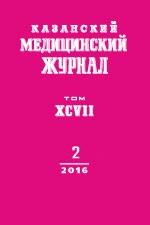Опыт использования оригинального эндокардиального электрода для временной стимуляции сердечной деятельности
- Авторы: Осмоловский А.Н.1, Бабенкова Л.В.1
-
Учреждения:
- Витебский государственный ордена Дружбы народов медицинский университет
- Выпуск: Том 97, № 2 (2016)
- Страницы: 177-181
- Раздел: Теоретическая и клиническая медицина
- Статья получена: 13.05.2016
- Статья опубликована: 15.04.2016
- URL: https://kazanmedjournal.ru/kazanmedj/article/view/2897
- DOI: https://doi.org/10.17750/KMJ2016-177
- ID: 2897
Цитировать
Полный текст
Аннотация
Цель. Оценить эффективность использования оригинального пункционного трансвенозного временного эндокардиального пружинистого электрода у пациентов с инфарктом миокарда, осложнённым брадиаритмиями.
Методы. В исследование включены 126 больных инфарктом миокарда, осложнённым острыми брадиаритмиями. Оригинальный эндокардиальный электрод был использован у 38 пациентов (основная группа). В 88 случаях брадиаритмий временное искусственное управление ритмом сердца осуществляли с использованием эндокардиального пружинистого временного пункционного электрода (контрольная группа). У всех пациентов, подвергшихся процедуре, брали письменное информированное согласие, а при отсутствии контакта с пациентом решение о проведении временной кардиостимуляции принимал врачебный консилиум.
Результаты.В разное время искусственного ритмовождения у 13 пациентов основной группы и 32 пациентов контрольной группы произошло спонтанное прекращение кардиостимуляции. Благодаря конструктивным особенностям используемого оригинального электрода, летальные исходы были предотвращены у 11 (84,6%) пациентов основной группы. У 9 из 32 пациентов контрольной группы с нарушенным ритмовождением кардиостимуляция была восстановлена повторной фиксацией электрода к эндокарду правого желудочка сердца. 23 пациентам контрольной группы восстановили искусственный ритм способом репозиции эндокардиального электрода. Количество больных со спонтанным прерыванием временного искусственного управления ритмом сердца имело сильную корреляционную связь с количеством пациентов с выявленными новыми изменениями на электрокардиограмме (элевация сегмента ST с рецидивом острого инфаркта миокарда; r=0,84, р
Вывод. При спонтанном прерывании временной электрокардиостимуляции, обусловленном утратой миокардом токопроводящей функции в зоне контакта с электродом, для эффективного и безопасного предотвращения летальных исходов рекомендовано использование эндокардиального электрода оригинальной конструкции.
Об авторах
Александр Николаевич Осмоловский
Витебский государственный ордена Дружбы народов медицинский университет
Автор, ответственный за переписку.
Email: Lariza_1970@mail.ru
Лариса Васильевна Бабенкова
Витебский государственный ордена Дружбы народов медицинский университет
Email: Lariza_1970@mail.ru
Список литературы
- Деревщиков С.А. Пособие дежуранта. Рекомендации для практических врачей по лечению неотложных состояний. Горно-Алтайск. 2014; 493 с.
- Осмоловский А.Н., Бабенкова Л.В. Способ фиксации эндокардиального электрода. Патент на изобретение №2973 Республики Беларусь. Бюлл. №3 от 30.09.1999.
- Осмоловский А.Н., Бабенкова Л.В., Сахарчук Л.С. Эндокардиальный электрод. Патент на изобретение №6056 Республики Беларусь. Бюлл. №1 от 30.03.2004.
- Осмоловский А.Н., Бабенкова Л.В. Способ контроля фиксации эндокардиального электрода. Патент на изобретение №7092 Республики Беларусь. Бюлл. №1 от 26.03.2005.
- Осмоловский А.Н., Бабенкова Л.В. Способ репозиции эндокардиального электрода при спонтанном прерывании искусственного ритмовождения. Патент на изобретение №10672 Республики Беларусь. Бюлл. №1 от 21.02.2008.
- Осмоловский А.Н., Бабенкова Л.В. Пункционная трансвенозная временная эндокардиальная электростимуляция сердца: новые возможности. Тезисы докладов VII съезда анестезиологов-реаниматологов «Актуальные проблемы и современные технологии в анестезиологии и интенсивной терапии». Под ред. Г.В. Илюкевича. Минск. 2012; 243-245.
- Осмоловский А.Н., Бабенкова Л.В. Брадиаритмии в остром периоде инфаркта миокарда: клиника, лечение и профилактика. Витебск. 2012; 255 с.
- Черкасов В.А., Протопопов В.В., Молодых С.В. Опыт применения электрокардиостимуляции в условиях санитарной авиации. Вестн. аритмол. 2006; (41): 27-32.
- ACC/AHA/ACP-ACIM. Guidelines for the management of patients with chronic stable angina. A report of the American College of Cardiology/American Heart Association Task Force оn practice guidelines. J. Am. Coll. Cardiol. 2003; 41: 159-168.
Дополнительные файлы







